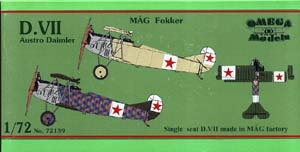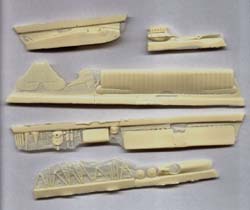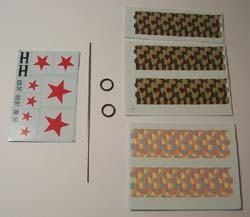Omega Models 1/72 MÄG Fokker D.VII
w/ Austro-Daimler
|
 |
History:
What I know of Austro-Hungarian production of the Fokker D.VII fighter
would fit in a shoebox, with room left over for the shoes, but from what
I gather this kit represents a MAG built D.VII with a 225-hp Austro-Daimler
engine used by the Hungarian Red Airborne Corps in 1919. A far better
history of the type and its use is available at Chandelle
The Kit:
Color profiles of two machines adorne the sturdy top opening box, one
in lozenge and one in Clear Doped Linen, both very striking. The box contains
twenty-eight parts in cream-colored resin, decals, two rubber O-rings,
a length of steel rod for tail struts and an instruction sheet.
The kit parts are broken up onto four resin pour blocks, with almost
all parts carried in the thin wafer making removal quite simple. Surface
texture is excellent, with no visible air bubbles or pebbling.
 As
is the norm with the Omega kits I've seen, the fuselage is cast as a single
piece, with an opening in the upper fuselage for the engine and cockpit
and a decking piece to complete the assembly. What is nice about this
kit is that the decking is provided in three pieces, allowing the engine's
upper side cowling pieces to be left off, showing more of the lovely little
engine. The Daimler engine is cast in a single piece and is very nice,
but it looks like the six single exhaust stubs will have to be added from
stretched sprue, a simple task. Push rods made from fine wire could really
add a nice touch if desired. As
is the norm with the Omega kits I've seen, the fuselage is cast as a single
piece, with an opening in the upper fuselage for the engine and cockpit
and a decking piece to complete the assembly. What is nice about this
kit is that the decking is provided in three pieces, allowing the engine's
upper side cowling pieces to be left off, showing more of the lovely little
engine. The Daimler engine is cast in a single piece and is very nice,
but it looks like the six single exhaust stubs will have to be added from
stretched sprue, a simple task. Push rods made from fine wire could really
add a nice touch if desired.
Cockpit walls have structural details integrally cast and the rudder
pedals, seat, stick, throttle and insturments, though delicate, should
pose no problem to remove from their carrier and use.
Once assembly and painting are complete the upper decking, MAG radiator,
prop and Schwarzlose machine guns can be added, then it's on to the wings
and tail which are all well cast and follow standard construction steps.
The resin wing struts look very nice, but for piece of mind, it might
be better to replace the landing gear struts as the solid fuselage and
wings can be quite heavy and cause flexing over time. As stated earlier,
a short length of thin steel rod is provided for the tail struts.
 Wheels
are provided as rubber O-rings that fit over resin centers, but will need
to be painted, as the tires of this period were a light grey. Wheels
are provided as rubber O-rings that fit over resin centers, but will need
to be painted, as the tires of this period were a light grey.
Three lengths of upper four-color lozenge and two lengths of lower
are provided for the lozenged machine, but proper application of these
is unclear; the boxtop shows the lozenged machine to have Olive upper
wing surfaces, so some research is in order here.
A second decal sheet provides the emblems for the Red Hungarian Air
Corps, a red star on a white background, and two serial numbers as well
as a mysterious 'H'
All of the decals look very good but a note included advises care during
application and the use of decal solvents.
The double sided 8.5 X 11 instruction sheet contains a brief history,
parts layout diagram, two photos, scale drawings and two assembly diagrams
as well as color callouts given in AGAMA and Humbrol paints. Even though
colors are given, their proper application is not addressed at all, not
a big obstacle for most modelers, but an unusual omission from a set of
instructions. No rigging diagram is given, but with the wealth of information
available on the D.VII this should be no trouble to track down.
Conclusion:
A nicely cast resin kit that should be easy to clean up and assemble
and should result in a sharp looking model, especially if the engine is
left partially exposed. The instruction sheet could be more helpful in
respect to painting and decaling, but if you are one, like me, who enjoys
the research associated with building models or if you are already familiar
with the subject, this will not be much of a deterrant. If all else fails,
a visit to the WW1 Modeling Page
should be quite helpful.
Recommended to all WW1 buffs, Fokker Fans, Russian Civil War nuts and
Austro-Hungarian enthusiasts.
Thanks to Jan Pala at Omega for the review sample
|
|
